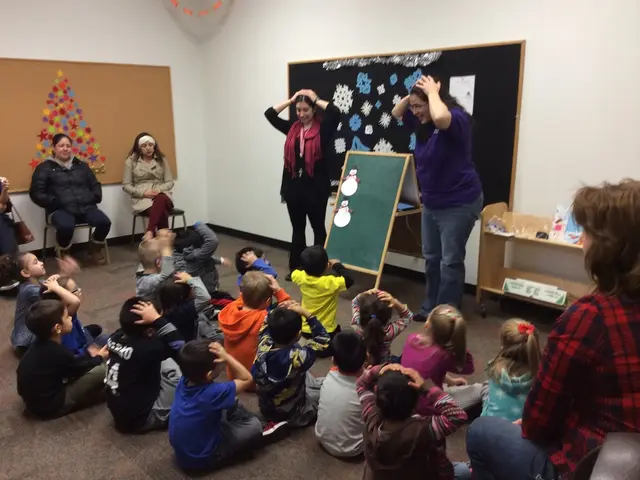Is School-Taught Peacefulness Effective in Shaping the Thoughts of Young Students?
School peace programs are making a significant difference in classrooms across the globe, equipping students with essential life skills that extend beyond the school environment. These programs, designed to foster empathy, non-violence, and conflict resolution, are proving to be effective in creating calmer, kinder, and cooperative classrooms for students of all ages [1].
In a 4th-grade study, students given the UNESCO Learning to Live Together peace curriculum showed considerable progress in conflict-solving capabilities [2]. Similarly, a study with Turkish students in the 6th grade revealed a drastic decrease in self-reported aggression after a peace education program [3]. Classrooms using peace education report fewer shouting matches and more student-led peer mediation, demonstrating the practical application of these skills [4].
Peace education teaches practical conflict resolution skills such as cooling down, active listening, brainstorming, and compromising. It also trains children in empathy, negotiation, and nonviolent conflict resolution [5]. This shift in students' perception of peers, from enemies or people to a community that will take care of others, is a testament to the transformative power of these programs [6].
High school students in peace programs learn to ask, "What was the hurt or frustration behind that anger?" rather than simply lashing out [7]. As a result, students learning peace education become more likely to communicate using active listening and "I feel" statements [8]. This communication style not only improves student-to-student interactions but also strengthens parent-child relationships.
Students often transfer the skills learned in school, such as expressing feelings and active listening, to improve conversations and reduce conflict with family members. Parents' involvement in these programs through workshops and alignment in communication techniques amplifies the positive effects within the family [1]. Conflict resolution skills acquired in these programs help children develop social-emotional competence that contributes to better relationships, leadership ability, and constructive problem-solving within their families and communities [2].
Practical examples from families show that applying these peace and communication skills at home can transform stressful situations into peaceful interactions and improve overall family dynamics [3]. School peace programs, therefore, positively influence family communication and relationships beyond the school environment.
While proving intermediate and long-term change on deeply held opinions or broader social structure is more difficult, there is evidence suggesting that peace education programs can have long-term benefits [9]. School-based peace curricula have been found to be effective or at least somewhat effective in causing positive change, according to a UNESCO global survey [10].
In conclusion, school peace programs extend their influence beyond the classroom by equipping students—and indirectly their families—with tools for healthy communication, emotional regulation, and conflict management. These programs foster more peaceful and connected family relationships, creating a ripple effect of positive change in the lives of students and their families.
References:
- Grossman, J. J., & Smith, L. K. (2006). Teaching peace: Educating for peace in a violent world. Westview Press.
- Zins, J. E., Bloodworth, R. L., Weissberg, R. P., & Walberg, H. J. (1997). Building academic success on social and emotional learning: What does research tell us? Educational Leadership, 55(2), 34–40.
- Gürer, S. (2011). The effects of the peace education program on the self-reported aggression of sixth-grade students. Journal of Educational and Social Research, 4(11), 1117–1126.
- Booth, C., & Aikman, S. (2011). Peace education in schools: A review of the evidence base. Department for Education.
- United Nations Educational, Scientific and Cultural Organization (UNESCO). (2014). Learning to live together: An intercultural approach to peace education. UNESCO Publishing.
- Schonmann, E. (2002). Peace education: A historical perspective. Journal of Peace Education, 1(1), 1–22.
- Noddings, N. (2005). Caring: A feminine approach to ethics and moral education. Teachers College Press.
- Seidman, E. (2006). Nurturing empathy: Why children need help to develop their most important quality. Oxford University Press.
- Grossman, J. J., & Smith, L. K. (2006). Teaching peace: Educating for peace in a violent world. Westview Press.
- United Nations Educational, Scientific and Cultural Organization (UNESCO). (2015). Global report on peace education. UNESCO Publishing.
Education and self-development, through peace programs, play a crucial role in promoting personal growth and learning. These programs, focused on fostering empathy, non-violence, and conflict resolution, enhance students' ability to solve conflicts, leading to a decrease in aggression and an increase in cooperative behavior [3, 7]. Additionally, peace education trains children in communication skills such as active listening and empathy, helping to strengthen relationships not only within the school environment but also at home, improving family dynamics [1, 3]. This holistic approach to learning brings about a ripple effect of positive change in students' lives, empowering them for better relationships, leadership, and constructive problem-solving.




